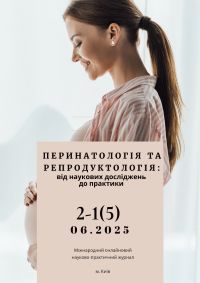Clinicalandanamnestic factors of risk of relapse of retrochorial haematoma
Keywords:
retrochorial haematoma, relapse, risk factorsAbstract
DOI: 10.52705/2788-6190-2025-02.1-07
УДК 618.344-003.215-036.87-06
The objective: to estimate clinical-and-anamnestic factors of risk of relapse of retrochorial haematoma.
Materials and methods. For the decision of the put purpose it was conducted complex clinicaland-laboratory and instrumental inspection 90 women, what were up-diffused on three groups on the basis of results of clinical inspection and information of ultrasonic research: 30 pregnant of woman with a recurrent retrochorial haematoma (basic group), 30 pregnant with a retrochorial haematoma, which appeared only on the early terms of pregnancy (6–12 weeks inclusive) (group of comparison) and 30 the prospective inspected patients with uncomplicated pregnancy, which do not have meaningful extragenital pathology and burdened factors obstetric-gynaecological to anamnesis (control group).
Results. A factor of burden of gynaecological anamnesis is one of most meaningful for patients with a recurrent retrochorial haematoma [RR – 1,922; 95% CI 1,541–2,394], even as compared to pregnant at diagnosticating of haematoma only in early terms [RR – 2,31; 95% CI 1,758–3,031]. Especially important factor of infecting (at 4,5 time more frequent at recurrent haematomas and
at 3,3 time – at the haematomas of early terms), absence of pregravid eradication of contagiums (only in 16,7% pregnant with a recurrent haematoma pregravid was conducted antibacterial therapy), and also presence in anamnesis intrauterine insertion (concerning hyperplasia of endometrium, submucous uterine fibroids, infertility) – at 4,2 time more frequent for women with
recurrent haematomas and at 3,3 time more frequent at the haematomas of early terms, what at uncomplicated pregnancy. Important presence in anamnesis and to the moment of offensive of pregnancy of uterine fibroids (thus more frequent during a conduct before pregnancy of operative treatment), use of different methods of assisted reproductive technologies, special conduct of cryoprotocol and unsuccessful attempts in vitro fertilization.
Conclusions. Motion of previous pregnancies, reproductive losses, is complicated, a scar on an uterus is the factors of risk of violations of placentation and forming of retrochorial haematoma. Pregnancy as a result of assisted reproductive technologies is constrained from 2,5-multiple in anamnesis promotes the risk of this complication the increase of frequency of retrochorial
haematoma, curettage of cavity of uterus at 2,4 time, uterine fibroids and second infertility – at 2,1
time, and presence of scar on an uterus after C-section at 2,8 time.
Findings must be taken into account at development of algorithm of diagnostic and treatment-andprophylactic measures.
Downloads
Published
How to Cite
Issue
Section
License

This work is licensed under a Creative Commons Attribution-ShareAlike 4.0 International License.


